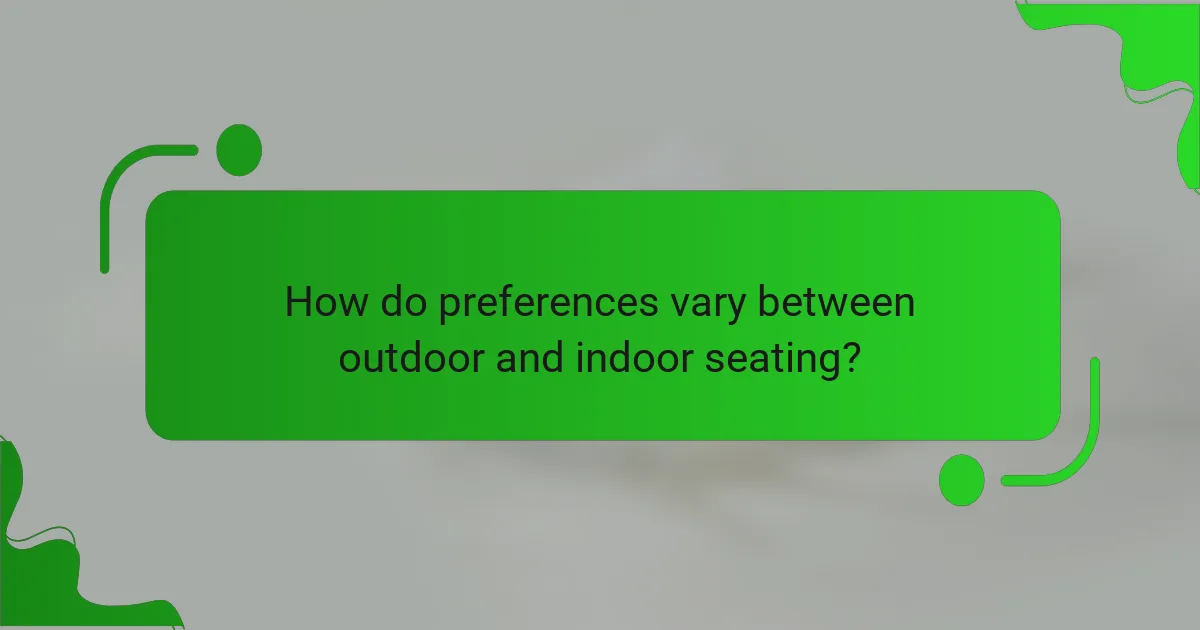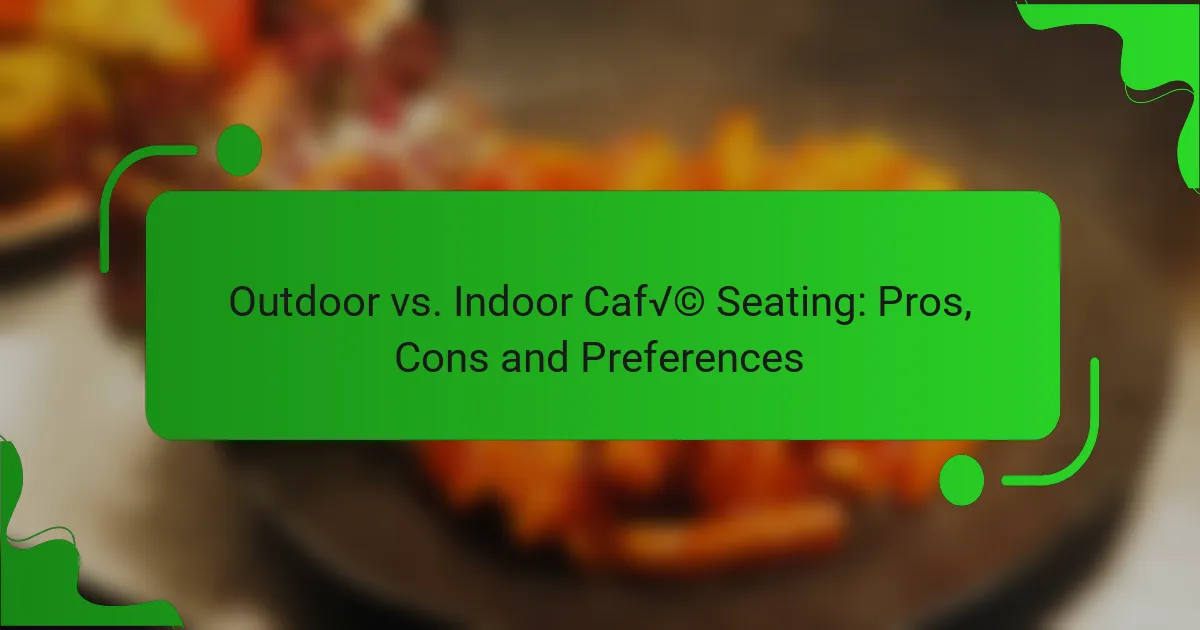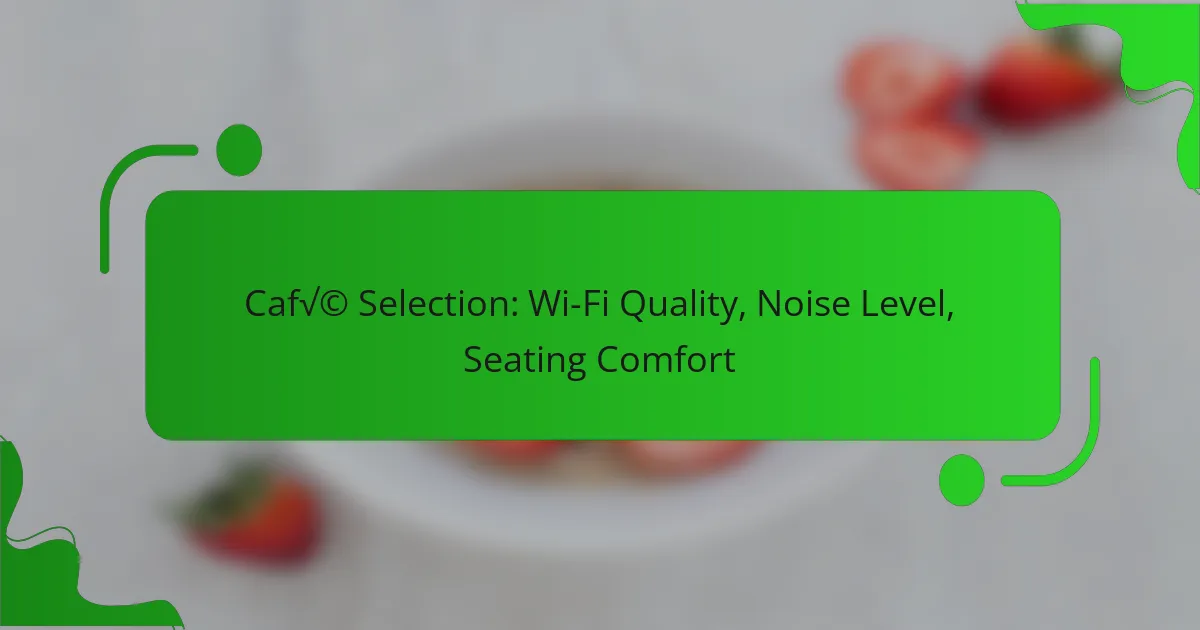When choosing between outdoor and indoor café seating, patrons and café owners alike must weigh the unique benefits and drawbacks of each option. Outdoor seating provides a lively atmosphere and the chance to enjoy pleasant weather, while indoor seating offers comfort and a controlled environment. Understanding these factors can help in making informed decisions that enhance the overall dining experience.

What are the pros of outdoor café seating in Los Angeles?
Outdoor café seating in Los Angeles offers a vibrant dining experience, allowing patrons to enjoy the city’s pleasant weather and lively atmosphere. This setup can enhance customer satisfaction and increase foot traffic, making it a popular choice for café owners.
Enhanced ambiance and atmosphere
Outdoor seating creates a unique ambiance that can attract customers looking for a relaxed dining experience. The natural surroundings, combined with the sounds of the city, can enhance the overall mood, making it more enjoyable for guests.
Many cafés utilize decor, such as string lights and plants, to create an inviting outdoor space. This aesthetic appeal can differentiate a café from competitors, drawing in more patrons.
Increased customer capacity
Having outdoor seating allows cafés to accommodate more customers, especially during peak hours. This can significantly boost revenue, as more tables mean more potential sales.
In Los Angeles, where outdoor dining is popular, cafés can often double their seating capacity by utilizing patios or sidewalks, maximizing their space effectively.
Natural light and fresh air benefits
Outdoor seating provides customers with access to natural light and fresh air, which can enhance their dining experience. Many people prefer to dine outside for the health benefits associated with being in a natural environment.
Exposure to sunlight can improve mood and increase vitamin D levels, making outdoor cafés an attractive option for health-conscious individuals.
Potential for scenic views
Los Angeles is known for its beautiful scenery, and outdoor café seating can offer stunning views of the city, mountains, or beaches. This scenic backdrop can enhance the dining experience and encourage customers to linger longer.
Cafés strategically located near parks or waterfronts can capitalize on these views, making their outdoor seating even more appealing.
Social interaction opportunities
Outdoor seating fosters a social atmosphere, encouraging interaction among customers. This can create a lively environment where people feel comfortable engaging with friends or meeting new acquaintances.
Moreover, outdoor cafés often attract a diverse crowd, which can enhance the social experience and make it a hub for community engagement.

What are the cons of outdoor café seating in Los Angeles?
Outdoor café seating in Los Angeles presents several drawbacks, including weather dependency, noise distractions, and comfort issues during extreme temperatures. These factors can significantly affect the overall dining experience for patrons.
Weather dependency and variability
Outdoor seating is highly dependent on weather conditions, which can change rapidly in Los Angeles. Rain, wind, or excessive heat can deter customers from enjoying their meals outside, leading to potential revenue loss for café owners.
Additionally, seasonal variations can impact the comfort level of outdoor dining. For instance, summer months can bring high temperatures, while winter evenings may require heating solutions to keep patrons comfortable.
Noise and distraction factors
Outdoor cafés often face challenges from noise and distractions, such as traffic, construction, or nearby events. These factors can disrupt conversations and diminish the overall ambiance, making it less appealing for customers seeking a relaxing experience.
Moreover, the presence of other diners can contribute to a crowded atmosphere, further complicating the enjoyment of outdoor seating. This can lead to a less intimate dining experience compared to indoor options.
Limited comfort during extreme temperatures
Extreme temperatures can pose significant comfort issues for outdoor café seating. In Los Angeles, summer heat can be intense, making it uncomfortable for patrons to dine outside without adequate shade or cooling solutions.
Conversely, chilly evenings in the fall and winter may require additional heating elements, which can be costly and logistically challenging to implement. This variability can deter customers from choosing outdoor seating during certain times of the year.
Maintenance and cleanliness challenges
Outdoor seating areas require more frequent maintenance and cleaning compared to indoor spaces. Dust, debris, and bird droppings can accumulate quickly, necessitating regular upkeep to maintain a pleasant dining environment.
Additionally, outdoor furniture may be more susceptible to wear and tear from exposure to the elements, leading to higher replacement costs over time. Café owners must factor in these maintenance challenges when considering outdoor seating options.

What are the pros of indoor café seating in Los Angeles?
Indoor café seating in Los Angeles offers a range of advantages, particularly in terms of comfort and atmosphere. Patrons can enjoy a controlled environment that enhances their dining experience, regardless of the weather outside.
Climate control and comfort
Indoor seating allows cafés to maintain a comfortable temperature year-round, shielding customers from the heat of summer or the chill of winter. Air conditioning and heating systems ensure that patrons can enjoy their meals without discomfort, making it a preferred choice for many.
Additionally, indoor spaces can be designed with comfortable seating arrangements, providing a cozy atmosphere that encourages longer visits. This comfort can lead to increased customer satisfaction and repeat business.
Consistent ambiance and decor
Indoor cafés can curate a specific ambiance through controlled lighting, decor, and music, creating a unique experience that reflects the café’s brand. This consistency in atmosphere can attract customers looking for a particular vibe, whether it’s a quiet study space or a lively social hub.
Moreover, indoor decor can be tailored to seasonal themes or special events, enhancing the overall experience for patrons. This flexibility in design is harder to achieve with outdoor seating, where environmental factors play a significant role.
Reduced noise and distraction
Indoor seating typically offers a quieter environment compared to outdoor areas, which can be affected by street noise, traffic, and weather conditions. This reduction in distractions allows customers to focus on conversations or work, making it an ideal setting for meetings or studying.
Furthermore, indoor cafés can implement soundproofing measures to enhance the acoustic experience, ensuring that patrons can enjoy their time without interruptions from external noise.
Year-round usability
Indoor café seating is usable throughout the year, regardless of weather changes. While outdoor seating may be limited to pleasant days, indoor spaces can accommodate guests in any season, maximizing business opportunities.
This year-round usability is particularly beneficial in a city like Los Angeles, where unpredictable weather can impact outdoor dining. By providing a reliable indoor option, cafés can ensure a steady flow of customers at all times.

What are the cons of indoor café seating in Los Angeles?
Indoor café seating in Los Angeles has several drawbacks, including limited natural light, potential overcrowding, and reduced opportunities for social interaction. These factors can impact the overall experience for patrons seeking a comfortable and enjoyable environment.
Limited natural light exposure
Indoor cafés often lack sufficient natural light, which can create a less inviting atmosphere. In a city like Los Angeles, where sunshine is abundant, patrons may prefer spaces that allow them to enjoy the outdoors. Insufficient lighting can lead to a dreary ambiance, making it less appealing for customers to linger.
To enhance the indoor experience, cafés can consider using large windows or skylights to maximize daylight. However, this may not always be feasible due to building constraints or costs.
Potential for overcrowding
Indoor seating can quickly become overcrowded, especially during peak hours. This can lead to a cramped environment where patrons feel uncomfortable and rushed. In Los Angeles, where many cafés are popular, the risk of overcrowding is significant, particularly in smaller venues.
Cafés can manage this by implementing reservation systems or limiting the number of patrons allowed inside at one time. Creating a comfortable space is essential for retaining customers and ensuring a pleasant experience.
Less social interaction
Indoor seating may limit social interaction compared to outdoor options. Patrons seated indoors might feel more isolated, especially if the café is quiet or lacks communal seating arrangements. In contrast, outdoor seating often encourages mingling and conversation among guests.
Cafés can foster a more social atmosphere by designing their indoor spaces with communal tables or hosting events that encourage interaction. This can help mitigate the feeling of isolation that some customers may experience indoors.

How do preferences vary between outdoor and indoor seating?
Preferences for outdoor versus indoor café seating often depend on factors like weather, ambiance, and personal comfort. Many patrons enjoy the fresh air and scenery of outdoor seating, while others prefer the controlled environment and comfort of indoor spaces.
Demographic influences on seating choice
Demographics play a significant role in determining seating preferences. Younger individuals and families with children may gravitate towards outdoor seating for its lively atmosphere, while older adults or professionals might prefer the quieter, more stable indoor environment.
Additionally, cultural factors can influence choices. In warmer climates, outdoor seating is often more popular year-round, while in colder regions, patrons may prioritize indoor seating during winter months. Understanding these demographic trends can help café owners tailor their seating arrangements to better meet customer needs.
Furthermore, social gatherings often dictate seating choices. Groups may opt for outdoor seating to enjoy a more casual, relaxed vibe, while business meetings typically take place indoors for privacy and comfort. Recognizing these patterns can enhance customer satisfaction and retention.



